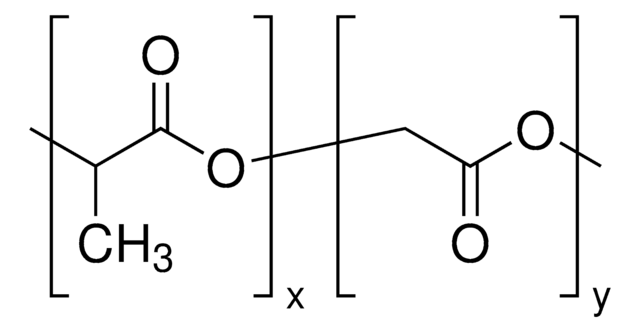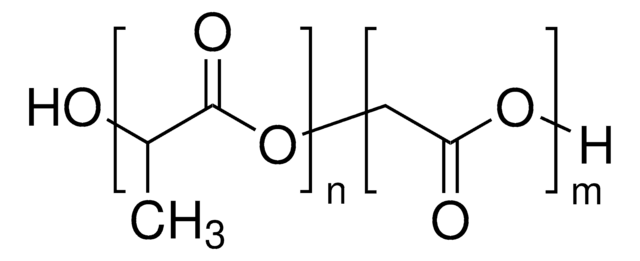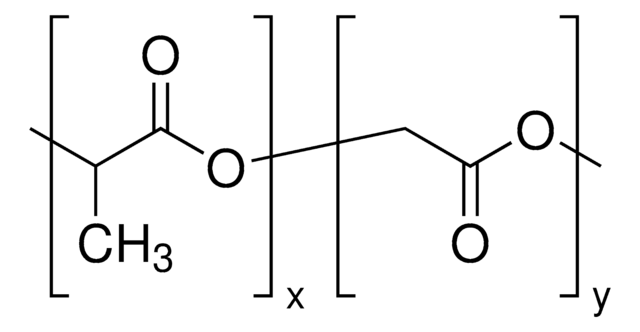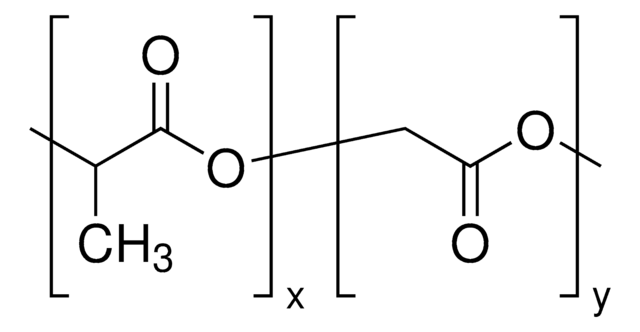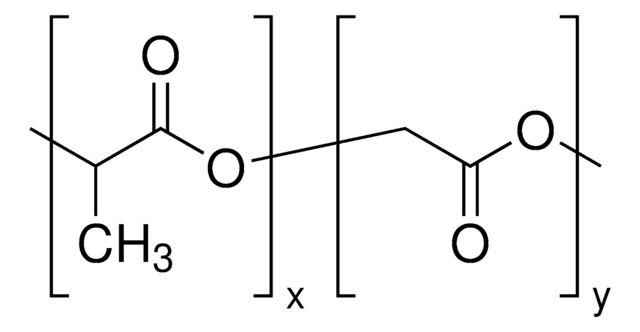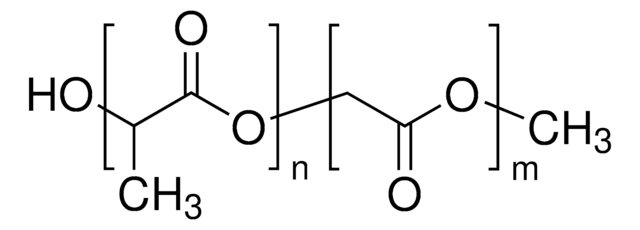Products may be shipped at a different temperature than the recommended long-term storage temperature. If the product quality is sensitive to short-term exposure to conditions other than the recommended long-term storage, it will be shipped on wet or dry-ice. If the product quality is NOT affected by short-term exposure to conditions other than the recommended long-term storage, it will be shipped at ambient temperature. As shipping routes are configured for minimum transit times, shipping at ambient temperature helps control shipping costs for our customers. For more information, please refer to the Storage and Transport Conditions document: https://www.sigmaaldrich.com/deepweb/assets/sigmaaldrich/marketing/global/documents/316/622/storage-transport-conditions-mk.pdf
추천 제품
Quality Level
양식
amorphous
피드(feed) 비율
lactide:glycolide 50:50
분자량
Mw 38,000-54,000
분해 기간
<3 months
점도
0.45-0.60 dL/g, 0.1 % (w/v) in chloroform(25 °C, Ubbelohde) (size 0c glass capillary viscometer)
전이 온도
Tg 46-50 °C
저장 온도
2-8°C
SMILES string
O2C(C(=O)OC(C2=O)C)C.O1CC(=O)OCC1=O
InChI
1S/C6H8O4.C4H4O4/c1-3-5(7)10-4(2)6(8)9-3;5-3-1-7-4(6)2-8-3/h3-4H,1-2H3;1-2H2
InChI key
LCSKNASZPVZHEG-UHFFFAOYSA-N
애플리케이션
It can be used to preparepolymer nanospheres for encapsulating CuO, to form stimuli-responsivemultifunctional nanocarriers.
법적 정보
관련 제품
Storage Class Code
11 - Combustible Solids
WGK
WGK 3
Flash Point (°F)
Not applicable
Flash Point (°C)
Not applicable
이미 열람한 고객
문서
Interest in utilizing biodegradable polymers for biomedical applications has grown since the 1960s.
Synthetic aliphatic polyesters dominate resorbable biomaterials in clinical use.
AliAliphatic polyesters, including polylactide and polyglycolide, are biodegradable polymers widely used in medical applications.
Immunosuppressive tumor-associated myeloid cells (TAMC) are responsible for glioblastoma (GBM) resistance to immunotherapies and existing standard of care treatments. This mini-review highlights recent progress in implementing nanotechnology in advancing TAMC-targeted therapies for GBM.
-
How is shipping temperature determined? And how is it related to the product storage temperature?
1 답변-
도움이 되었습니까?
-
-
How can I determine the shelf life / expiration / retest date of this product?
1 답변-
If this product has an expiration or retest date, it will be shown on the Certificate of Analysis (COA, CofA). If there is no retest or expiration date listed on the product's COA, we do not have suitable stability data to determine a shelf life. For these products, the only date on the COA will be the release date; a retest, expiration, or use-by-date will not be displayed.
For all products, we recommend handling per defined conditions as printed in our product literature and website product descriptions. We recommend that products should be routinely inspected by customers to ensure they perform as expected.
For products without retest or expiration dates, our standard warranty of 1 year from the date of shipment is applicable.
For more information, please refer to the Product Dating Information document: https://www.sigmaaldrich.com/deepweb/assets/sigmaaldrich/marketing/global/documents/449/386/product-dating-information-mk.pdf도움이 되었습니까?
-
-
What is the degree of polydispersity of Resomer® RG 504 H, Poly(D,L-lactide-co-glycolide)?
1 답변-
The degree of polydispersity for this product is calculated as the weight average molecular weight divided by the number average molecular weight (Mw/Mn). The specific value can be found on the Certificate of Analysis (COA) for each lot.
도움이 되었습니까?
-
-
Is the unit of the PLGA molecular weight of Resomer® RG 504 H, Poly(D, L-lactide-co-glycolide) Da?
1 답변-
Yes, the molecular weight unit of this product is in Da or daltons.
도움이 되었습니까?
-
활성 필터
자사의 과학자팀은 생명 과학, 재료 과학, 화학 합성, 크로마토그래피, 분석 및 기타 많은 영역을 포함한 모든 과학 분야에 경험이 있습니다..
고객지원팀으로 연락바랍니다.


